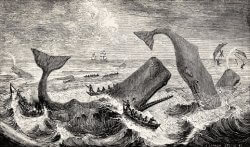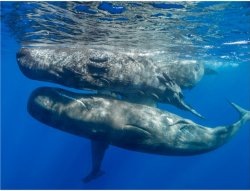How Sperm Whales Taught Each Other to Defeat Whaling Ships

From The Natural History of the Sperm Whale by Thomas Beale. New York Public Library.
Part Two of a series celebrating the cultures of whales
During the early 19th century, sperm whales in the Eastern Pacific found themselves being hunted down mercilessly with harpoons. But after a brief period of very prolific hunting, the success of the whalers began to drop dramatically. What had happened?
 Hal Whitehead, Professor of Biology at Dalhousie University, has been studying sperm whales in the ocean for more than 35 years.
Hal Whitehead, Professor of Biology at Dalhousie University, has been studying sperm whales in the ocean for more than 35 years.
Recently, he and his colleagues found themselves delving through the logbooks and records of the whalers, now preserved at museums in New England.
Knowing that the success of the giant whaling ships in killing sperm whales had taken a sudden downturn, they wanted to figure out the strategy that the whales had devised to thwart their attackers.
The way sperm whales had always protected their children from predators was by forming a tight protective circle around each baby.
So, that’s what they naturally did when the ships arrived and launched their smaller boats, manned by crews armed with harpoons, to attack them.
But what had always worked in the past was now the worst thing they could do: Being in a tight circle made it a lot easier for this new kind of predator to close in on them with its lethal weaponry.
 Poring through the logs and diaries of the whaling ships, Dr. Whitehead and his colleagues discovered that faced with their new enemy, the whales had figured out a new strategy: Abandoning the tight-circle defense, they had begun swimming fast upwind (harder for the whalers to keep up with them), diving deep (out of range), and even directly attacking the whalers in their boats (the large males could ram them with their huge heads).
Poring through the logs and diaries of the whaling ships, Dr. Whitehead and his colleagues discovered that faced with their new enemy, the whales had figured out a new strategy: Abandoning the tight-circle defense, they had begun swimming fast upwind (harder for the whalers to keep up with them), diving deep (out of range), and even directly attacking the whalers in their boats (the large males could ram them with their huge heads).
Even more remarkable to Dr. Whitehead’s team was seeing how fast the whales had learned these new maneuvers. And the only explanation was that as families figured out new tactics, they must have been teaching them to others.
“We’ve known for many years that whales learn things like calls and dialects from their families,” he says. “But this is a remarkably fast and wide-spread change in whale culture.”
Dr. Whitehead, an advisor to the Whale Sanctuary Project, talks more about these insights in a lively webinar from last May. You can watch it here.
Next page: Orcas – a Tale of Many Cultures